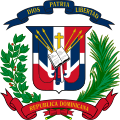Tugna:Coat of arms of the Dominican Republic.svg

Taille de cet aperçu PNG pour ce fichier SVG : 336 × 336 iferdisen n tugna. Tibuda nniḍen : 240 × 240 iferdisen n tugna | 480 × 480 iferdisen n tugna | 768 × 768 iferdisen n tugna | 1 024 × 1 024 iferdisen n tugna | 2 048 × 2 048 iferdisen n tugna.
Afaylu aneṣli (Afaylu SVG, tabadut n 336 × 336 pixel, lqedd : 504 KB/KO)
Amazray n ufaylu
Senned ɣef yiwen azmez d usrag iwakken ad ẓṛeḍ afaylu aken yella deg imir nni.
| Azemz/Ssaɛa | Aqmamaḍ | Iseggiwen | Amseqdac | Awennit | |
|---|---|---|---|---|---|
| Lux a | 23 Ctember 2022 à 23:57 |  | 336 × 336 (504 KB/KO) | Risantana | Reverted to version as of 13:27, 3 March 2015 (UTC) |
| 23 Ctember 2022 à 23:55 |  | 600 × 600 (199 KB/KO) | Risantana | Reverted to version as of 18:12, 5 September 2020 (UTC) | |
| 28 Fuṛaṛ 2022 à 17:26 |  | 610 × 610 (199 KB/KO) | FDRMRZUSA | Fixed slight imperfection. Added margin (5 pixels) around the image. Optimized svg code before upload. No other changes. | |
| 5 Ctember 2020 à 18:12 |  | 600 × 600 (199 KB/KO) | FDRMRZUSA | Fixed slight imperfections. Optimized svg code with code cleanup and reduction. No other changes. | |
| 11 Fuṛaṛ 2019 à 18:56 |  | 600 × 599 (235 KB/KO) | FDRMRZUSA | Higher svg resolution from same file (latest version): resized by "Inkscape". Optimized: reduced svg code. No other changes. | |
| 3 Meɣres 2015 à 13:27 |  | 336 × 336 (504 KB/KO) | Djmasterd | Este es el que mas se asemeja a lo estipulado en la Constitución Dominicana (Ultima Modificación 2010), en su Artículo 32. Donde indica que el Escudo contiene 4 banderas y 2 lanzas. | |
| 9 Mayyu 2013 à 01:58 |  | 336 × 336 (492 KB/KO) | Risantana | No son tres lanzas en cada lado, sino DOS. La constitución dominicana establece en su articulo 32, sobre el escudo la parte que dice: '''un trofeo integrado por dos lanzas y cuatro banderas nacionales sin escudo, dispuestas a ambos lados'''... Is not... | |
| 1 Ɣuct 2012 à 23:19 |  | 336 × 336 (504 KB/KO) | Fry1989 | come on | |
| 1 Ɣuct 2012 à 23:16 |  | 336 × 336 (504 KB/KO) | Fry1989 | fix | |
| 20 Yulyu 2012 à 19:39 |  | 336 × 336 (504 KB/KO) | Fry1989 | new arms by Cheposo |
Aseqdec n ufaylu
Asebter agi teseqdac afaylu agi :
Aseqdec n ufaylu amatu
Iwikiyen-agi-nniḍen seqdacen afaylu-agi:
- Aseqdec ɣef ab.wikipedia.org
- Aseqdec ɣef af.wikipedia.org
- Aseqdec ɣef als.wikipedia.org
- Aseqdec ɣef am.wikipedia.org
- Aseqdec ɣef ang.wikipedia.org
- Aseqdec ɣef an.wikipedia.org
- Aseqdec ɣef ar.wikipedia.org
- أمريكا الشمالية
- هسبنيولا
- جمهورية الدومينيكان
- علم جمهورية الدومينيكان
- الدين في الرموز الوطنية
- شعار جمهورية الدومينيكان
- قائمة شعارات دول أمريكا الشمالية
- تجارة العبيد عبر الأطلسي
- بيزو دومنيكاني
- رافائيل تروخيو
- قائمة شعارات الدول
- بوابة:جمهورية الدومينيكان
- بوابة:جمهورية الدومينيكان/واجهة
- قالب:مواضيع جمهورية الدومينيكان
- قالب:سياسة جمهورية الدومينيكان
- أقاليم جمهورية الدومينيكان
- محافظات جمهورية الدومينيكان
- الحرب الأهلية الدومينيكانية
- الدين في جمهورية الدومينيكان
- نشيد جمهورية الدومينيكان الوطني
- كونغرس جمهورية الدومينيكان
- احتلال الولايات المتحدة لجمهورية الدومينيكان (1916-1924)
- توحيد هسبنيولا
- حرب الاستعادة الدومينيكية
- مجزرة البقدونس
- جمهورية هايتي الإسبانية
- رينيه كلانج دى جوزمان
- جمهورية الدومينيكان الثالثة
- الاحتلال الإسباني لجمهورية الدومينيكان
- الباتشاتا (الرقص)
- Aseqdec ɣef ary.wikipedia.org
- Aseqdec ɣef arz.wikipedia.org
- Aseqdec ɣef ast.wikipedia.org
Wali l’utilisation globale n ufaylu-agi.



